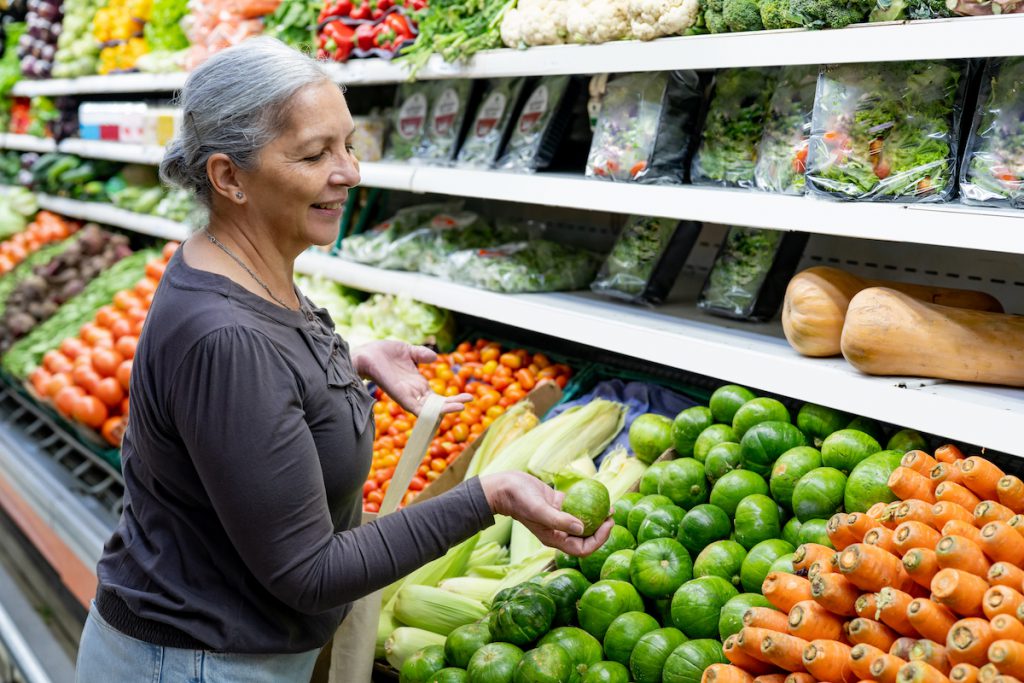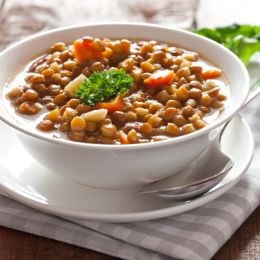6 Healthy-Eating Secrets of the Blue Zone Diet
These smart food strategies help some of the world’s longest-living people thrive well into their 90s. We’re sharing their best nutrition secrets with you.

If you haven’t heard about Blue Zones before, it’s time to start paying attention. These geographical areas were identified by National Geographic explorer Dan Buettner, and they are the five cities in the world that statistically have some of the longest-living and healthiest populations:
- Okinawa, Japan
- Sardinia, Italy
- Nicoya, Costa Rica
- Ikaria, Greece
- Loma Linda, California
Despite their geographical differences, these cities all have several lifestyle habits in common that contribute to their notable longevity, including some ways that they approach food and mealtime.
The life expectancy in the Blue Zones isn’t just higher. Many older adults are also healthier than the norm, with their minds and bodies still sharp and strong deep into their golden years.
Want to age like they do? Try these six eating strategies for better odds for a longer, healthier and happier life.
Healthy eating and fitness go together! SilverSneakers classes and events are happening daily at participating gyms, online through SilverSneakers LIVE, and at community centers near you. Activate your free online account to get started.
1. Eat More Plants
Meatless Mondays and plant-based foods are all the rage in the U.S. these days, but people who live in the Blue Zones ate plenty of plants long before it became trendy. They may eat tofu in Okinawa and beans and rice in a Costa Rican village, but eating less meat and more legumes, whole grains, seasonal fruits and local garden vegetables and herbs is a common thread among these five places.
A constant flow of scientific research supports this approach. A study of more than 75,000 adults in the journal Circulation found that those who consistently eat a healthy, plant-based diet — like choosing whole grains instead of processed carbs — were less likely to die young from heart disease.
Healthy plant-based foods are rich in micronutrients, fiber and antioxidants that help lower the risk for several other deadly diseases too, such as diabetes and cancer. Vegetarian fare also often has fewer calories, which also helps keep body weight lower throughout your life cycle.
For the most part, most healthy older people living in Blue Zones aren’t strict vegetarians. They eat meat and high-fat dairy less often and in smaller portions than what is typical in a standard American diet. If you don’t want to give up animal protein entirely, have 3 to 4 ounces of lean meat, chicken or fish a few times a week. The rest of your plate should be filled with plant-based foods.
Recommended reading: How to Start Eating Plant-Based: The SilverSneakers Guide
What Is the Flexitarian Diet—and Should You Try It?
2. Make a Bigger Breakfast and Smaller Lunch and Dinner
Blue Zone residents tend to eat their largest meals early in the day. And research backs that concept up: According to the International Journal of Obesity, people who ate a higher percentage of daily calories within two hours of waking were at lower risk of being overweight or obese than those who eat the most two hours before going to bed at night.
A different study found that eating more calories earlier in the day can also lower your risk of death from diabetes and cardiovascular disease. Experts suspect that eating early may provide some metabolism advantages and help people make healthier food choices. Not many Blue Zone centenarians are snacking on potato chips late at night, after all.
3. Remember That Beverages Have Calories Too
The drinks of choice in Blue Zones are typically water, coffee, tea and a little wine. Missing from this list are sugary beverages, particularly soda, which are terrible for good health and longevity. According to the Centers for Disease Control and Prevention, consuming a lot of beverages sweetened with sugar can lead to obesity, type 2 diabetes, and heart, kidney and liver disease.
Coffee lovers, take note: Old-timers in Sardinia, Nicoya and Ikaria aren’t drowning their coffee with syrups either. If you make an effort to greatly limit the amount of liquid sugar you consume, you’ll be one step closer to aging well.
Recommended reading: 6 New Ways to Flavor Your Coffee Without Sugar
4. Eat Mindfully
Blue Zone residents tend to stop eating before they are stuffed, perhaps before they have finished everything on their plate or are too full to eat another bite. In Okinawa, they tend to practice the mindful approach known as hara hachi bu. That is the cultural practice of eating until you are 80% full to better control calorie intake.
You can develop this skill too:
- Slow down when you eat and don’t distract yourself with your phone or the TV.
- Set your utensil down between bites to increase awareness and enjoyment of your meal.
- Chew food more slowly, so you’re more likely to notice you’re full, rather than continuing to munch when your body already has the calories it requires.
Recommended reading: Think Yourself Slimmer: Your 4-Step Plan
5. Enjoy Meals With Others
Blue Zone researchers have found that social interaction is a major factor in their longevity. This is why you should make an effort to break bread with others and make mealtime a chance to catch up with friends and family whenever possible.
Researchers from the University of North Carolina found that those who had more social relationships were less likely to test poorly for blood pressure, waist circumference and inflammation, both early and later in life. Another study reported that older adults were also at risk of having a lower-quality diet if they lived and ate alone.
6. Grow Some of Your Own Food
Even at their advanced age, there are Blue Zone centenarians still actively gardening. It’s a regular part of daily life for many of these residents, and research shows that people who dig in the dirt eat more fiber and are more physically active.
Growing a vegetable garden isn’t an option for everyone, of course. If you have mobility issues or don’t have outdoor space where you live, consider joining a community garden. The act of being outside in a green space can lower the risk for developing type 2 diabetes, high blood pressure and heart disease. It can also increase your odds of socializing with other people.
Recommended reading: 6 Surprising Health Benefits of Gardening
The Blue-Zone Foods You Should Be Eating
Consider adding these healthy options to your weekly shopping list.
Subscribe to our newsletter
It's quick and easy. You could be one of the 13 million people who are eligible.
Already a member? Click to discover our 15,000+ participating locations.
Follow Us
Beans: Packed with fiber, plant protein, vitamins and minerals, legumes are an important longevity food in all Blue Zone regions. Look for ways to sneak more into your diet via soups, salads and dips like hummus.
Whole grains: Sardinians adore their barley and Nicoyans favor corn tortillas. Whole grains deliver more fiber and nutrients than their refined counterparts.
Goat dairy: In the hills of Sardinia and Ikaria, organic goat and sheep milk and cheese are more common than cow-based options. This may provide nutritional advantages including higher levels of anti-inflammatory omega-3 fats.
Tofu: Older Okinawans have made the plant-based protein a staple of their diets. It’s lower in calories than meat and contains disease-preventing plant compounds.
Nuts: Research has found that the Blue-Zone habit of snacking on nuts is one of their healthy-living secrets. They deliver a nutritional wallop of healthy fats, minerals and antioxidants.
Olive oil: Ikarians eat a variation of the Mediterranean diet that makes frequent use of extra-virgin olive oil, which provides cholesterol-crushing monounsaturated fat and anti-inflammatory compounds.
Local fruit: From papaya to seasonal berries, locally sourced fruit is a big player in Blue Zone nourishment. Follow their lead by hitting up your local markets for nutrient-dense fruits that are grown close to home.
Leafy greens: While vegetables of all kinds abound in each Blue Zone diet, highly nutritious dark leafy greens like spinach are especially prized.
See our sources:
Blue Zones: National Geographic
Dietary habits of people who live in Blue Zones: Nutrients
Plant-based diet and heart disease risk: Circulation
Meal timing and obesity: International Journal of Obesity
Meal timing and mortality: Diabetes Care
Social interaction and longevity: Proceedings of the National Academy of Sciences
Health risks of living alone: Social Science and Medicine
Health benefits of gardening: Lancet Planet Health
Activate Your FREE SilverSneakers Online Account
Get hundreds of free SilverSneakers On-Demand videos and stay in touch with us by creating your free online account. You don’t have to be a SilverSneakers member to get on-demand workout videos, health and fitness tips from SilverSneakers, and more.
SilverSneakers members can go to thousands of nationwide gyms and fitness locations, plus take SilverSneakers LIVE online classes led by specially trained instructors and designed for all fitness levels and abilities – at no additional cost. If you have a Medicare Advantage plan, it may include SilverSneakers. Check your eligibility here.
Already a member? Get your SilverSneakers member ID, search for locations near you, and all the health and wellness resources you need by logging in to your online member account here.





